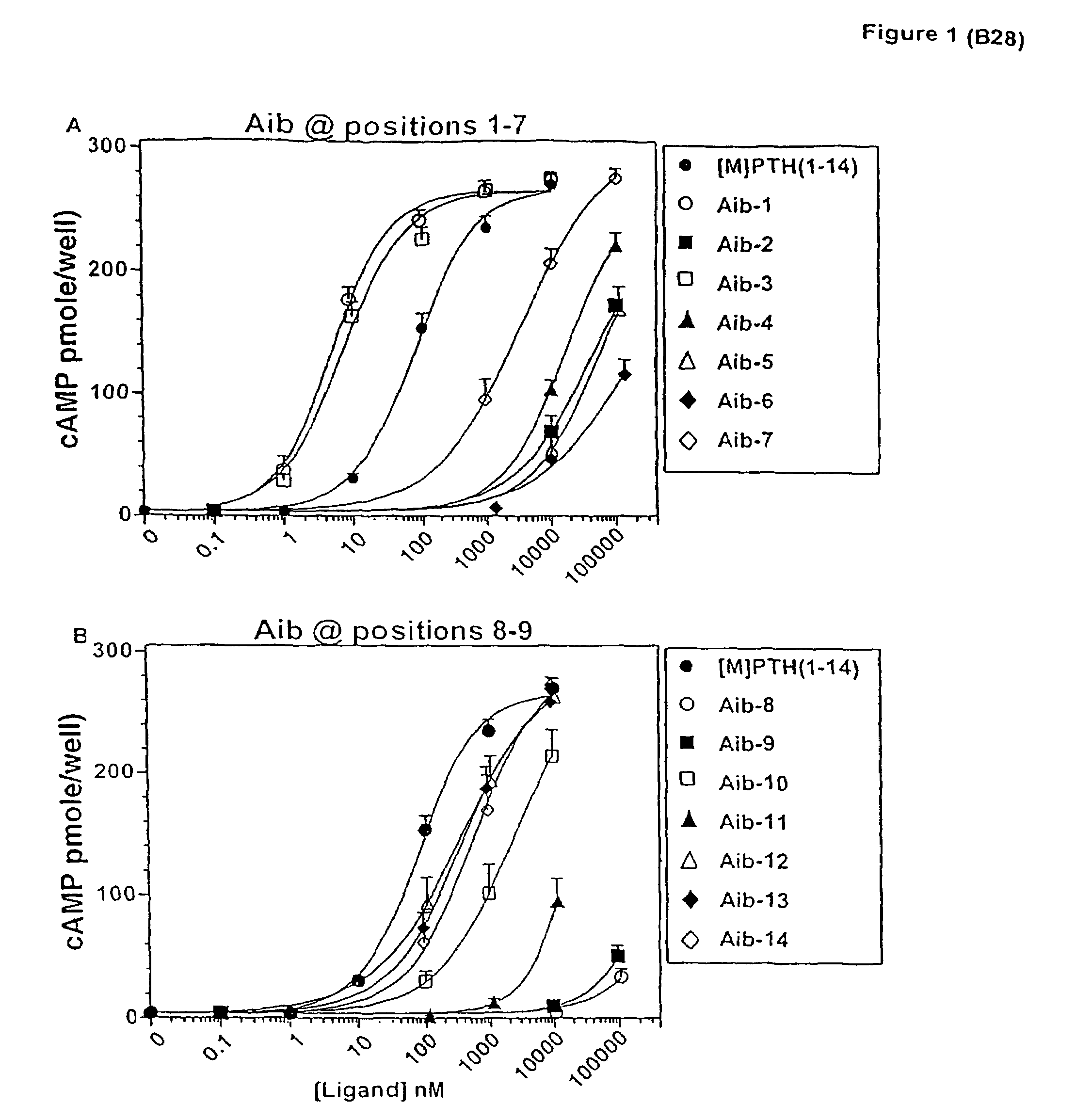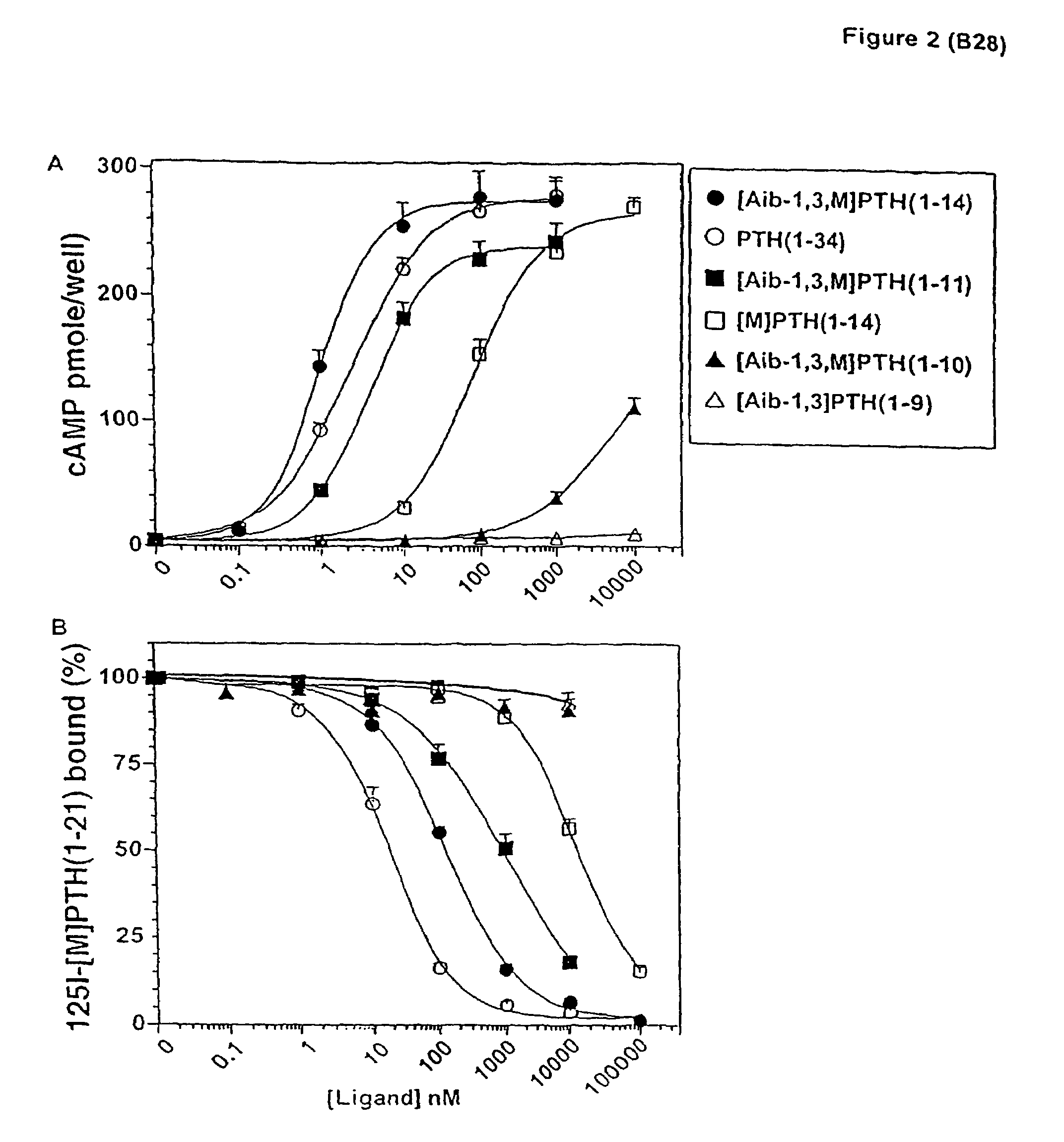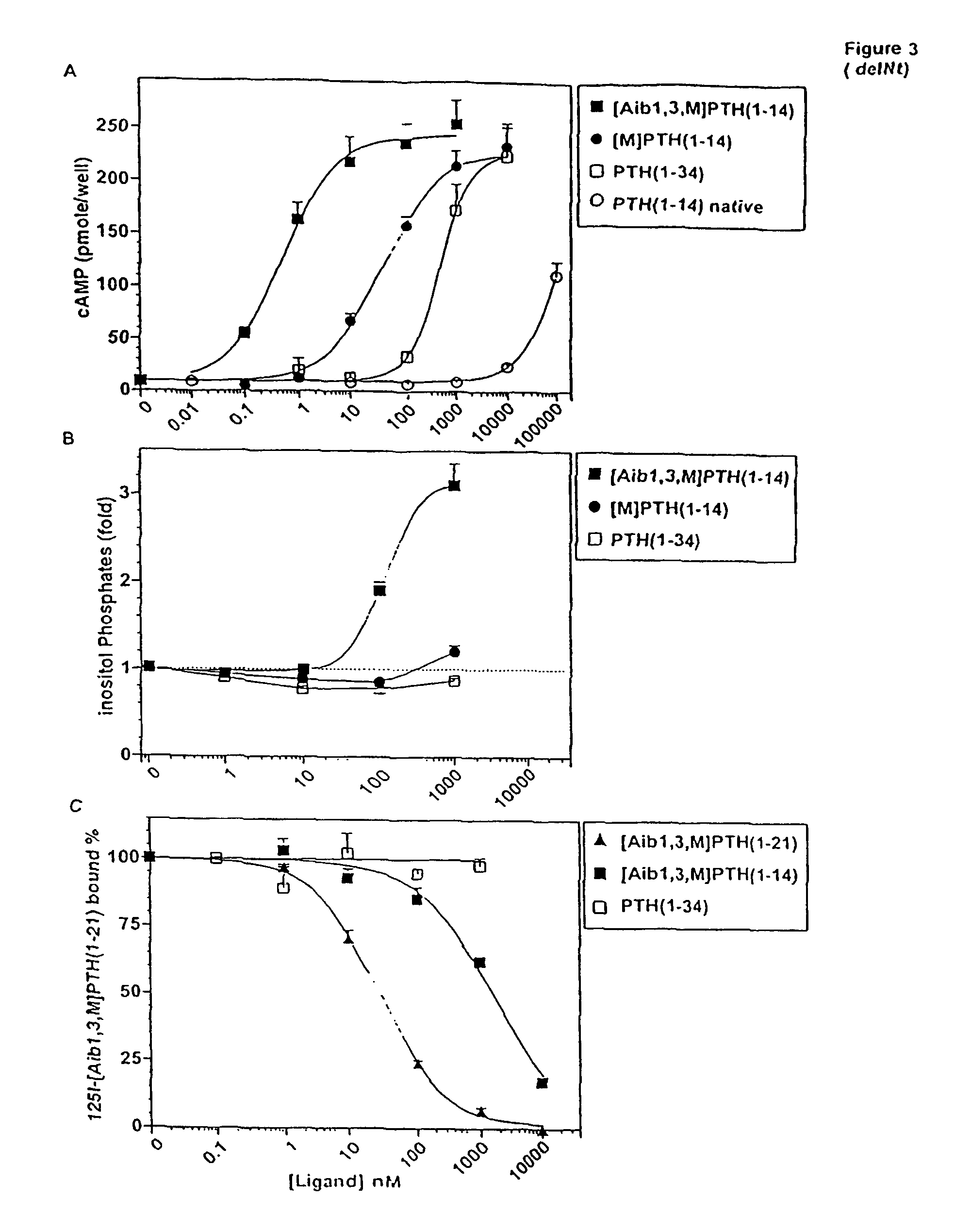Conformationally constrained parathyroid hormone (PTH) analogs
a parathyroid hormone and conduction restriction technology, applied in the field of conduction restriction parathyroid hormone (pth) analogs, can solve the problems of reducing bone mineral density (bmd), reducing bone strength, and reducing bone mass, so as to reduce bone mass and bone mass.
- Summary
- Abstract
- Description
- Claims
- Application Information
AI Technical Summary
Benefits of technology
Problems solved by technology
Method used
Image
Examples
example 1
Aib-scan in [M]PTH(1-14)
[0095]The effect of introducing individual Aib substitutions at each position in the scaffold peptide [M]PTH(1-14) (Shimizu, M., et al., Endocrinology (2001) (In Press))) were analyzed. In cAMP stimulation assays in HKRK-B28 cells, the parent peptide [M]PTH(1-14) stimulated approximately the same (˜70-fold) maximun (Emax) increase in intracellular cAMP that was induced by PTH(1-34), but the potency (EC50) of the shorter peptide was 40-fold less than that of PTH(1-34) (EC50 s=100±20 and 2.5±0.4. nM, respectively) (FIG. 1 and Table 1). Most of the Aib substitutions diminished potency. Severe reductions occured with Aib substitutions at positions 6, 8 and 9 (all>2,300-fold), moderate reductions occurred with substitution at positions 2, 4, 5 and 11 (all 170 to 670-fold) and minor reductions occurred with substitutions at positions 7, 10, 12, 13 and 14 (allMolecular Endocrinology 13:670-680 (1999); Shimizu, M., et al., J. Biol. Chem. 275:19456-19460 (2000); Pelle...
example 2
Analog Activity in COS-7 Cells
[0100]The possibility that the activity-enhancing effects of the Aib substitutions at positions 1 and 3 were mediated through the juxtamembrane (J) region of the receptor was investigated in COS-7 cells transiently transfected with P1R-delNt. P1R-delNt was a truncated P1R that lacked most of the amino-terminal extracellular domain. With this receptor construct, PTH(1-34) was a much weaker agonist than it was with P1R-WT, while other PTH(1-14) analogs exhibited approximately the same potency with P1R-delNt as with P1R-WT (Kaul, R., and Balaram, P., Bioorganic &Medicinal Chemistry 7:105-117 (1999)). Consistent with this, the cAMP-stimulating potency of [Aib1,3,M]PTH(1-14) on P1R-delNt (EC50=0.73±0.16 nM) was comparable to its potency on COS-7 cells expressing P1R-WT (1.2±0.6 nM) (Table 2). On P1R-delNt, [Aib1,3,M]PTH(1-14) was 55-fold more potent than was [M]PTH(1-14) (EC50=40±2 nM, FIG. 3A and Table 2). This result indicated that the potency-enhancing ef...
example 3
Activity in Bone Cells
[0105]The number of PTH-1 receptors expressed on the surface of the PTH target cells in bone or kidney is uncertain, but it is likely to be considerably lower than that found in HKRK-B28 cells. Therefore, several of the Aib-mounted PTH analogs were evaluated using SaOS-2 cells. These cells were derived from a human osteosarcoma, exhibited osteoblast-like properties and endogenously expressed relatively low levels of the PTH-1 receptor (˜20,000 receptors / cell (Marx, U. C., et al., J. Biol. Chem. 273:4308-4316 (1998)). In these cells, [Aib1,M]PTH(1-14) and [Aib3,M]PTH(1-14) were 15- and 8-fold more potent in stimulating cAMP formation than was [M]PTH(1-14), and [Aib1,3,M]PTH(1-14) was 130-fold more potent than [M]PTH(1-14) (FIG. 4 and Table 3). Thus, in SaOS-2 cells, [Aib1,3,M]PTH(1-14) was only 13-fold less potent than PTH(1-34) and at least five-orders of magnitude more potent than native PTH(1-14), for which no activity could be detected, even at a dose of 10 ...
PUM
| Property | Measurement | Unit |
|---|---|---|
| pH | aaaaa | aaaaa |
| molecular weight | aaaaa | aaaaa |
| time | aaaaa | aaaaa |
Abstract
Description
Claims
Application Information
 Login to View More
Login to View More - R&D
- Intellectual Property
- Life Sciences
- Materials
- Tech Scout
- Unparalleled Data Quality
- Higher Quality Content
- 60% Fewer Hallucinations
Browse by: Latest US Patents, China's latest patents, Technical Efficacy Thesaurus, Application Domain, Technology Topic, Popular Technical Reports.
© 2025 PatSnap. All rights reserved.Legal|Privacy policy|Modern Slavery Act Transparency Statement|Sitemap|About US| Contact US: help@patsnap.com



